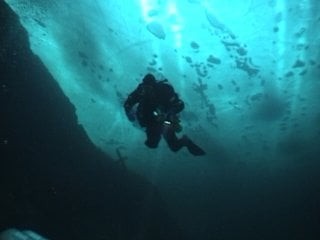This article does not present the complete picture of ice diving and does not replace proper training and experience. If the reader wishes to participate in ice diving or extreme cold water diving, they should take an ice diving course as well as a course on overhead environments like cave or wreck penetration.
“This is not happening”, I thought as my regulator hissed its last breath and exploded in a torrent of air giving me the ultimate ice cream headache. I quickly switched to my backup regulator an attempted, in vain, to close down the free flowing primary. I scanned the vicinity to find my buddies but they were too far away to render assistance or even know I was in trouble. As my life support bubbled away I immediately felt myself becoming more buoyant, followed shortly by my flailing form breeching the surface while still trying to shut down the free flow. Abandoning the valve closure I decided it was more prudent to inflate my wing, with what little gas I had left, so I would not drown mere meters from the dock.
So ended one of my early attempts at cold water diving. In retrospect, I was very lucky, all things considered, but the experience left me shaken because it exposed a variety of vulnerabilities and mistakes that would have been costly in a slightly harsher environment. Had the surface been frozen or the dive closer to decompression limits, I may not have gotten away unscathed. I was convinced that my pitiful performance was inexcusable, based on 10 years of diving experience, and if I was to continue I had to master this new frontier.
I am often asked, “Why bother to ice dive at all”? My replies don’t always seem to convince the skeptics, but the advantages seem clear to most serious divers. Mainly it allows diving in areas that can’t be accessed in summer, usually places with high recreational or commercial boat traffic. In winter time the visibility of water improves dramatically, especially underneath ice, because many of the algae and other organisms have died due to the cold and reduced light levels. Personally, however, I believe the surreal beauty of a frozen climate makes the discomfort and potential dangers all worth experiencing, if only for one time.
Dealing with cold
Winter diving in a northern climate can expose a diver to surface air temperatures well below freezing and water temperatures at the freezing point. It is not uncommon to be diving with an air temperature of -15c/4F and a water temperature of 0c/32F. Prolonged exposure to these conditions above or below water is extremely detrimental to diving gear as well as physical and mental aspects of a diver.
Long exposure to cold can induce Hypothermia, where the body core temperature begins to drop affecting physiological and mental processes. What begins as shivering can quickly turn into fatigue, mental impairment (confusion), reduced motor control and eventually, loss of consciousness, organ failure and death. Once Hypothermia reaches the advanced stages only immediate re-warming the body can alleviate this condition.
 Frequently, diving takes place in areas that are not sheltered from the wind. Exposure to wind causes a body to lose heat much faster then normal, a condition known as Wind Chill. Divers need to take extra precautions on windy winter days to conserve as much warmth as possible before entering the water.
Frequently, diving takes place in areas that are not sheltered from the wind. Exposure to wind causes a body to lose heat much faster then normal, a condition known as Wind Chill. Divers need to take extra precautions on windy winter days to conserve as much warmth as possible before entering the water.
Divers can be affected by cold in other ways not evident until after the dive is complete or underway. Frostbite, snow blindness and even sunburn can all be concealed by cold, and the results not felt until back in a warm environment. The numbing affects of cold can easily give a false sense of warmth while the body is steadily being injured. Divers should watch their partners for any signs or symptoms related to prolonged exposure, even before a dive.
There is potentially no end to the list of problems encountered in an extremely cold climate. The only answer to all these problems is to keep your body as warm as possible before a dive; but, this can be easier said then done. Having access to a heated shelter or vehicle may be the only way to solve some of the issues but not always possible if a long way off shore.
Finally, a diver should be dressed accordingly for the climate and have a spare set of dry clothes in case the current set gets wet. Cap/hat, gloves, scarves, winter boots and winter jacket will be mandatory when diving in freezing temperatures. More importantly, however, a conscious effort must be made to avoid perspiring (sweating) while preparing for the dive. Any moisture against the skin will reduce the heat retention of any protective insulation and add to the discomfort level before entering the water.
Dealing with ice
Cold water mandates that a diver be more aware of their environment, themselves and their buddies. However, when precautions are taken, cold water diving is not unlike diving in warmer climates. It is when the temperature drops below freezing and the surface of the water becomes covered in ice, that the diver faces a totally new extreme environment. Diving in this environment can be as dangerous, if not more so, then any wreck or cave penetration in the world.
Ice is a very dynamic element that has been carving the face of our planet for eons. Ice forms on fresh water at 0c/32F and in salt water at slightly colder temperatures, depending on the salinity content. As water freezes into ice it expands causing a reduction in density that allows it to float. Affected by winds and currents large areas of floating ice tend to move around and collide with other patches of ice, forming small hills called Hummocks, overlapping layers called Rafting and cracks with liquid water called Leads. The pressure between these ice sheets can be enormous and needs to be treated with great respect.
When venturing out onto ice, a person has to be acutely aware of its thickness. Changes in current, temperature and wind can increase or reduce thickness creating wildly irregular ice cover. Ice can be as strong as steel and it takes only about 5cm/2” to support a human being, 10cm/4” can support small vehicles like snowmobiles and larger vehicles can easily be supported when the ice is 20cm/8” or more thick. For ice diving it is recommended that the thickness be at least 15cm/6” thick to support the added weight of scuba gear and multiple people.
For the purposes of this article I will concentrate on diving in fresh water sources like lakes, rivers and quarries.
Ice diving
 Traditional ice diving techniques, where divers are tethered to the surface and monitored by tenders, work very well but only allow for very limited diving. Better methods were needed if ice diving was going to be practical or any fun at all. More importantly, however, based on my experience described at the start of this article, the skill level and gear configuration had to be honed to razor sharp perfection before any attempt could be made to push the boundaries of ice diving. Ironically some of the answers I was looking for came from a very unlikely place.
Traditional ice diving techniques, where divers are tethered to the surface and monitored by tenders, work very well but only allow for very limited diving. Better methods were needed if ice diving was going to be practical or any fun at all. More importantly, however, based on my experience described at the start of this article, the skill level and gear configuration had to be honed to razor sharp perfection before any attempt could be made to push the boundaries of ice diving. Ironically some of the answers I was looking for came from a very unlikely place.
Florida, in the southern United States, is not known for its vast fields of ice or its legendary ice divers; but it does have one of the highest concentrations of cave divers in the world, along with some of the biggest cave systems. By adopting some of the latest cave diving techniques being developed there and combining it with traditional ice diving and wreck penetration diving techniques; a whole new universe could easily be explored. Fortunately, one of my buddies did a cave course in Florida and had already started adopting those techniques into his winter diving. By working together with him and other like minded divers we refined our techniques until we were able to explore under the ice as easily and safely as any summer recreational dive.
Ice vs. Cave
Simply put a frozen body of water is very similar to a submerged cave system with a few key exceptions. Caves have tunnels and restrictions that are connected to larger openings called rooms; however a frozen body of water is like a single gigantic room with no tunnels or restrictions. Caves tend to be devoid of any light at all, but there is always diffused light filtering through ice, the amount depends on how much snow has accumulated on top, ice thickness and how sunny it is. Water temperature in caves usually hovers around 15c/60F and slightly higher in tropical regions; you can expect ice filled water to always be near or below 0c/32F. Finally, caves tend to have entrances ready for divers, but on most occasions ice divers will have to make and maintain their own openings.
Ice dives are very similar to cave dives in terms of being in an overhead environment, therefore all cave diving skills and gear configurations are completely applicable to a frozen body of water. The use of reels or guide lines are mandatory and the diver must have the usual array of redundancy in terms of gas supply, lighting and other caving accessories. However, there are areas where an ice diver needs to pay special attention and where I will focus the rest of this discussion.
The Buddy System
Diving solo under ice, or in any overhead environment, is simply not an option. There are far too many factors that can affect a divers gear, physical and mental performance, irregardless of the skill and experience a diver takes with them. The best redundant safety equipment a diver can have is an identically configured like minded buddy.
Many divers argue that buddies do not always live up to their end of the deal and you end up diving solo anyway. This may be true, but it is not the buddy system that is at fault, it is the buddy they are diving with. For any overhead environment it is essential that a buddy team have gelled into a cohesive unit with a common goal and a heightened sense of awareness.
Buddy teams need to maintain close contact and be in constant communication at all times. A momentary lapse in range or communication can cause a separation that may not be easy to recover from, like a free flow causing a buddy to quickly float to the ceiling. By staying always within touch contact any sudden emergency can be instantly communicated to the buddy team and emergency procedures activated. A typical team formation consists of a close range single file group, with the lead diver laying a guide line down followed closely by the other members of the team. The person behind is always within touching distance of the person in front.
A bright focused beam light is another excellent way to stay within close communication. When going single file the diver behind can generally keep their beam within visual distance of the diver in front, assuring the diver in front that everything is normal. This also speeds up progress of the team not having to constantly check each member of the group. However, ice diving presents a unique problem rarely seen in cave diving, because of sunlight filtration, high ambient light levels may make it more difficult to spot a diver’s light beam, providing yet another reason for staying in close touch contact throughout the dive.
Ice divers need to be familiar with all the light/hand signals used in cave and wreck diving as well as carrying some sort of slate or wet notes for writing. Quick communication can help solve any issue encountered in an overhead environment.
Exposure Management
Zero degree water will rapidly chill any diver regardless of the quality or the amount of thermal protection used; it is just a matter of time. Divers must be aware of how long they can safely endure the cold, but this only comes with experience. A diver’s susceptibility to cold will change every day depending on many personal factors, so they have to be prepared to turn a dive, irregardless of the amount of gas left, if they sense a significant reduction in metal or physical performance. Once a diver has reached the stage of uncontrolled shivering, that person is a danger to themselves and to their buddy.
Uncontrollable shivering is an early sign of Hypothermia and even at this early stage the diver’s ability to perform may be seriously compromised. Their gas consumption rate will start to rise; they may become fatigued faster and may start to loose motor control as joints begin to stiffen. They may not be able to lend proper assistance to their buddy or they maybe additionally taxing to the buddy should they need assistance. Even when a cold stricken diver makes it back to the entrance they may not have enough strength to doff their gear and get out of the water.
Part II of this article will deal with the gear considerations for ice diving.

Sources:
Ice Diving (Third Addition)
Anthony C. Ferguson
Published: ACUC International 1996
